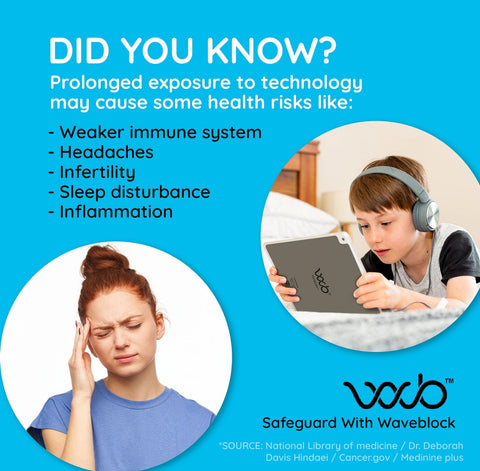
Are you Sensitive to EMF’s?
Are you feeling the heat from electromagnetic fields (EMFs)? Electromagnetic Sensitivity (ES) or Electromagnetic Hypersensitivity (EHS) denotes an intolerance to EMFs, resulting in a plethora of physical reactions. It's essential to recognize that EMFs emanate from various sources, ranging from the wiring in your home to everyday gadgets like refrigerators, fans, x-ray machines, and cellphones—even when they’re in “airplane” mode. Surprisingly, there are "fields" of energy even emanating from the earth.
How can you discern if you're EMF-sensitive? There is a very wide range of estimates of the prevalence of EHS in the general population. A survey of occupational medical centers estimated the prevalence of EHS to be a few individuals per million in the population. However, a survey of self-help groups yielded much higher estimates. Approximately 10% of reported cases of EHS were considered severe.
There is considerable geographical variability in the prevalence of EHS and in the reported symptoms. The reported incidence of EHS has been higher in Sweden, Germany, and Denmark than in the United Kingdom, Austria, and France. VDU-related symptoms were more prevalent in Scandinavian countries, and they were more commonly related to skin disorders than elsewhere in Europe. Symptoms similar to those reported by EHS individuals are common in the general population.

Studies
"ELECTROHYPERSENSITIVITY AS A NEWLY IDENTIFIED AND CHARACTERIZED NEUROLOGICAL DISORDER: HOW TO DIAGNOSE, TREAT, AND PREVENT IT" is the title of a groundbreaking research report by the eminent electromagnetic expert and scientist, Dominique Belpomme, released in March 2020. Drawing data from 2,000 EHS patients, Belpomme highlighted the urgency of classifying EHS as a neurological disorder in the International Classification of Diseases as he presented compelling evidence, stating, "EHS is becoming a new insidious worldwide plague involving millions of people."
It's noteworthy that 30% of these patients also grappled with multiple chemical sensitivities (MCS). Belpomme underscores the similarity in symptoms between EHS and MCS, emphasizing the commonality of low-grade inflammation and autoimmune responses. Individuals with sensitivities often react to various types of EMF, encompassing magnetic, electric, or high-frequency fields, culminating in a myriad of unpleasant symptoms such as headaches, limb pain, social isolation, skin rashes, insomnia, and other adverse reactions when exposed to wireless energy.

Despite overwhelming evidence, skepticism still abounds regarding the legitimacy of EHS. However, for those afflicted and the experts immersed in its study, the reality of sensitivity to man-made electromagnetic radiation and its polarized waveforms is undeniable.
"It is evident from our preliminary experimental data that various biological alterations are present in EHS persons claiming to suffer from exposure to EMF. The alterations are themselves enough to fully explain the EHS symptoms, and the involvement of the immune system is evident," asserts Olle Johansson, associate professor emeritus from the Karolinska Institute, Stockholm, Sweden, renowned for his contributions to Electromagnetic Hypersensitivity research.
The Case of Reza Ganjavi
In 2016, Reza Ganjavi, an IT professional originally from California but now residing in Zurich, began experiencing troubling symptoms. He found himself struggling to get a good night's sleep, plagued by headaches, fatigue, and a restless mind. What's more, he noticed an unexpected change—the appearance of more wrinkles, as if he were aging rapidly.
For Ganjavi, a committed yogi who adhered to an organic, vegetarian diet and avoided smoking and drugs, these symptoms were alarming. He embarked on a quest to identify the cause, scouring his surroundings for any changes. It wasn't until he was using his laptop one day that he stumbled upon a potential culprit—an unfamiliar Wi-Fi connection.
Upon investigating further, Ganjavi traced the source to a new Wi-Fi router installed by his landlord just meters from his front door. This discovery led him down a path of researching the effects of routers on health, eventually uncovering a concept he had never encountered before: electromagnetic hypersensitivity (EHS).
As an IT professional, the notion that his beloved Wi-Fi could be making him sick was deeply unsettling. Despite his initial reluctance, Ganjavi delved deeper into the issue, launching a website called EMF Crisis, petitioning, and advocating against 5G technology. Alongside his activism, he made significant changes to his lifestyle, opting for completely wired internet at home and shielding his apartment with specialized materials to block electromagnetic fields.
Despite his efforts, Ganjavi continued to experience symptoms when exposed to high levels of radiation, especially in urban areas with numerous cell towers or close proximity to Wi-Fi routers. To mitigate these effects, he adopted various strategies, such as staying in Wi-Fi-free Airbnbs during travel and using shielding blankets for protection on planes and trains.
Ganjavi emphasized that electromagnetic fields aren't just a concern for those with EHS; they can harm everyone. He cited numerous studies documenting the harmful effects, ranging from tumors and DNA damage to cognitive decline and behavioral issues. Ganjavi cautioned against relying solely on industry-funded studies, drawing parallels to the tobacco industry's history of downplaying risks.
In his ongoing battle against the pervasive presence of electromagnetic radiation, Ganjavi remains steadfast in his mission to raise awareness and advocate for safer technology usage.
Solutions
The good news is that there are measures to take, and WaveBlock offers effective products that diminish the impact of EMFs on the body. As with all electronic devices, it’s important to research the latest findings on the potential for negative results from prolonged usage. Limit the effects of EMF’s by reducing exposure to Bluetooth technology and keeping distance from devices while charging. WaveBlock is at the forefront of lab testing and transparency. Consider adding a WaveBlock sticker to your laptop, iPad, cell phone, or earbuds. You’ll feel better about taking a step toward living your best life.

WaveBlock® samBlock (Androids)

